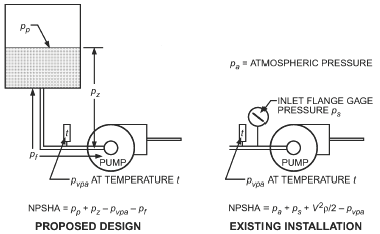Related Resources: pumps
Positive Net Suction NPSHA Analysis Formula
Pumps and Fluids Design and Analysis
Positive Net Suction Design and Analysis Formula
With the design of pump systems attention should be given to the pressure and temperature of the water as it enters the pump, especially in condenser towers, steam condensate returns, and steam boiler feeds. The pressure in excess of that required to prevent vapor pockets from forming is the Net Positive Suction Head Required (NPSHR). NPSHR is a characteristic of a given pump and varies with pump speed and flow. It is determined by the manufacturer and is included on the pump performance curve.
If the absolute pressure at the suction nozzle approaches the vapor pressure of the liquid, vapor pockets form in the impeller passages. The collapse of the vapor pockets (cavitation) is noisy and can be destructive to the pump impeller.
NPSHR is particularly important when a pump is operating with hot liquids or is applied to a circuit having a suction lift. The vapor pressure increases with water temperature and reduces the Net Positive Suction Head Available (NPSHA). Each pump has its NPSHR, and the installation has its NPSHA, which is the total useful energy above the vapor pressure at the pump inlet.
Note: There is a conversion calculator (pressure and stress) on the right side of this webpage
Equation 1.0
NPSHA = pp + pz - pvpa - pf
Where:
pp = absolute pressure on surface of liquid that enters pump, Pa
pz = static elevation of liquid above center line of pump, Pa
pvpa = absolute vapor pressure at pumping temperature, Pa
pf = friction and head losses in suction piping, Pa
To determine the NPSHA in an existing installation, Equation 1.2 may be used (see Figure 1.2):
Equation 1.2
NPSHA = pa + ps + ( ( V2 ρ ) / 2 ) - pvpa
Where:
pa = atmospheric head for elevation of installation, Pa
ps = head at inlet flange corrected to center line of pump
(hs is negative if below atmospheric pressure), Pa
( V2 ρ ) / 2 = velocity head at point of measurement of hs, Pa
ρ = density of fluid, kg/m3
hs = static head
If the NPSHA is less than the pump’s NPSHR, cavitation, noise, inadequate pumping, and mechanical problems will result. For trouble-free design, the NPSHA must always be greater than the pump’s NPSHR. In closed hot- and chilled-water systems where sufficient system fill pressure is exerted on the pump suction, NPSHR is normally not a factor.

Figure 1.2 Net Positive Suction Head Available [2016S, Ch 44, Fig 33]
Related:
Derived from resources provided by:
ASHRAE Pocket Guide for HVAC, 2013